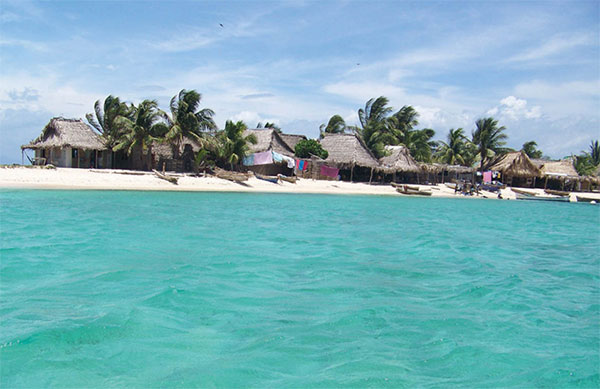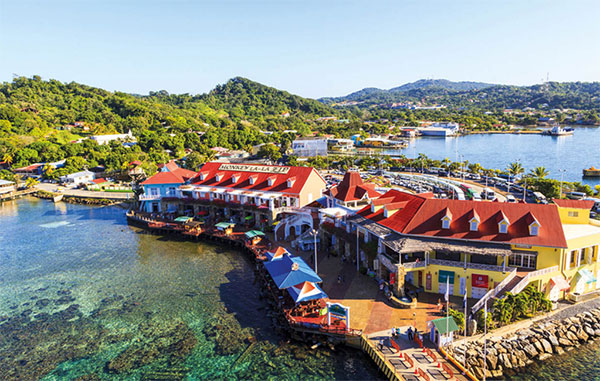Pico Bonito National Park
La Ceiba’s crown jewel is the 100,000-hectare (247,105-acre) Parque Nacional Pico Bonito ^ [map] . Ranging in altitude from sea level to more than 2,000m (6,500ft), there’s more biodiversity here than in any other natural reserve in Honduras. Seven different ecosystems can be found within the park, which contain large tracts of virgin rainforest and cloud forest, not to mention waterfalls and rivers. The range of species living here is staggering. Big cats like jaguars and pumas can be found in more remote corners of the park, though there are also tapirs, several species of monkeys, and hundreds of species of birds, butterflies, and reptiles.
The park is divided into two parts. On one side is The Lodge at Pico Bonito (www.picobonito.com), an upscale ecolodge that regularly ranks among the world’s best, with a gourmet restaurant and highly trained guides. From the lodge, guests and non-guests who come on day trips can access a network of immaculately maintained trails, bird-watching towers and swimming holes in the Coloradito River. A butterfly sanctuary and serpentarium can also be found on the grounds. The other section of the park is along the buffer zone at the Cangrejal River, up the mountain from the village of Las Mangas, west of La Ceiba, just beyond Sambo Creek. Upon crossing a hanging bridge over the river, there is one primary trail that leads to the 60 meter (196ft) El Bejuco Waterfall. This section of the park is more active, with a dozen or so small ecolodges. Adventure tour operators like Jungle River Tours (www.jungleriverlodge.com) set up rafting trips on the Class II-V Cangrejal that pass through pristine forests and over giant granite boulders.
Cayos Cochinos
Also known as the Hog Islands, the Cayos Cochinos & [map] are a cluster of tropical islands, cartoonish coral cays, and sandbars 30km (19 miles) northeast of La Ceiba. Part of the Mesoamerican Barrier Reef System, there are strict conservation rules, such as no commercial fishing within the 489 sq km (189 sq miles) reserve. The reef here, with 60 or so dive sites, is as good, if not better, than any you will find in the Bay Islands and includes walls, drifts and small wrecks. There are good chances of seeing manta rays, bottlenose dolphins, whale sharks, and hawksbill turtles. The two main islands, Cayo Menor and Cayo Mayor, provide accommodations in a small hotel and a few private homes, plus a hiking trail, and a research station. The only permanent settlement belongs to the Garífuna community of Chachauate Cay, which lacks running water and electricity. Here, small restaurants serve typical dishes to day-trippers and rent out hammock spaces for those that want to stay longer.
Trujillo
At the end of the north coast highway CA-13, 165km (102 miles) east of La Ceiba, is the town of Trujillo * [map] . It was here, on August 14, 1502, that Christopher Columbus – on his fourth and final voyage – set foot on the American mainland for the first time. There have long been rumblings about turning Trujillo into a major beach and cruise destination, and with its wide beaches and unspoiled forests it still might achieve its potential, but since Hurricane Mitch hit in 1998 and caused considerable damage, those plans have been on hold.
The colonial center of town is on a hilltop, guarded by a row of canons at the Santa Bárbara fort (daily 8am–noon, 1–4pm), erected in the 17th century to guard against pirate attacks. There is a small museum with muskets and other relics from British rule on display. One of the only other attractions in town is the old cemetery, where the three-centuries-old graves are usually overgrown with weeds. The most notable grave belongs to American adventurer William Walker, who, after a failed attempt of taking over Costa Rica, fled to Trujillo and took over the fort before surrendering to Honduran authorities and being swiftly executed.
Unpaved roads from the town along the coast lead to the Garífuna communities of Santa Fe and Guadalupe. Santa Fe, 12km (8 miles) to the west, has some nice beaches and Comedor Caballero, better known as Pete’s Place, a traditional Garífuna restaurant with some of the best seafood on the North Coast.
The 4,500-hectare (11,119-acre) Capiro y Calentura National Park, occupying the mountainous jungle behind Trujillo, has very little infrastructure and is understaffed. A dirt path on the southern end of town will lead to the Calentura mountain summit in about three hours.

Chachahuate Cay on Cayos Cochinos is a Garífuna community.
Shutterstock
The Bay Islands
For several centuries, as the Spanish raided the New World for gold, the Bay Islands were used as hideouts for French and English pirates, including famous buccaneers like Henry Morgan and John Coxen. After war broke out between England and Spain in 1739 the British took control of the islands and set up forts at Port Royal in Roatán; however, battles until the end of the 18th century left the islands uninhabited. At Punta Gorda in 1797, the British dumped a few thousand Garífuna, many of whom settled on the east end, where their culture is widely celebrated. New waves of settlers arrived from the Caymans in the following centuries and, even though Honduras was granted sovereignty to the islands in 1859, there is a completely different air than on the mainland.

Roatán Port.
Shutterstock
Roatán
Most tourism to the islands rotates around Roatán ( [map] , the largest of the Bay Islands at 64km long (40-mile). It’s here that the cruise industry has sunk about $100 million into modern ports, Mahogany Bay and the Port of Roatán’s Town Center, which have attracted waves of oversized cruise ships that come to the island as part of longer Caribbean itineraries. When cruise ships are in town, much of the island loses its charm, filling roads with tour buses and crowding West Bay beach.
Most development has taken place on the Western half of the island. The crystal clear waters of West Bay Beach, the best in Honduras, has seen a surge in development over the past decade and resorts and condo projects have bought up every last hectare. In the hills above West Bay is Gumbalimba Park (www.gumbalimbapark.com; daily 8am–4pm) an island adventure park with watersports, a monkey island, and a canopy tour that’s often visited by cruise travelers. West End, reached by road or water taxi from West Bay, is the older center of tourism here and the main hangout for the dive community. Hotels are smaller and less polished here than in West Bay and many of the restaurants and bars are owned by expats.
Sandy Bay is dominated by the all-inclusive resort at Anthony’s Key (www.anthonyskey.com), which is set up on the shore and an adjoining cay. At attached Bailey’s Key, operated by the Roatán Institute for Marine Sciences, there is a dolphin encounter and dolphin training program. Carambola Gardens (www.carambolagardens.com), also in Sandy Bay, has several trails that weave through the island’s native flora and fauna.
Coxen Hole, in the center of the island, is home to the majority of the population and is the transportation hub of Roatán. Aside from cruise tourists arriving at the nearby Port of Roatán, there’s little reason to come here. Mahogany Bay, the other cruise port, which was formerly known as Dixon’s Cove, has a white sand beach, but it’s still not West Bay.
The town of French Harbour was once the home of the island’s fishing fleet, but now the marinas are filled with yachts and the town filled with expats. It’s more of a residential area, though there’s one large resort, Pristine Bay (www.pristinebayresorts.com), with the Pete Dye-designed Black Pearl golf course.
Connected along the coast through canals, the eastern towns of Oakridge and Jonesville are mostly Afro-Antillean, with people residing in traditional-style stilt houses. Boatmen line the road offering short tours through the mangroves, stopping at the famous restaurant Hole in the Wall, reached only by boat. Punta Gorda, where the paved road ends, is where the Garífuna first arrived from St. Vincent in 1797, though there is little beyond here other than the excellent beaches of Camp Bay and Paya Bay, which has a small resort (www.payabay.com).